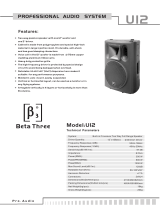QSC MD series powered full range speakers User manual
- Category
- Portable speakers
- Type
- User manual
This manual is also suitable for
QSC MD series powered full range speakers
These powered full-range speakers provide excellent sound quality and quality construction. They are energy-efficient and have clean power amplification on-board. There is a multitude of models with a common cabinet design, making installation easier.
The speakers are self-contained and have optimized equalization and crossover. They also have a rotatable high-frequency horn, 15 attachment points, and minimal weight increase over non-powered versions. This makes them suitable for various applications.
They are available in black or white and are perfect for house-of-worship, performing arts center, and arena applications that demand flexible and excellent-sounding system solutions.
QSC MD series powered full range speakers
These powered full-range speakers provide excellent sound quality and quality construction. They are energy-efficient and have clean power amplification on-board. There is a multitude of models with a common cabinet design, making installation easier.
The speakers are self-contained and have optimized equalization and crossover. They also have a rotatable high-frequency horn, 15 attachment points, and minimal weight increase over non-powered versions. This makes them suitable for various applications.
They are available in black or white and are perfect for house-of-worship, performing arts center, and arena applications that demand flexible and excellent-sounding system solutions.













-
 1
1
-
 2
2
-
 3
3
-
 4
4
-
 5
5
-
 6
6
-
 7
7
-
 8
8
-
 9
9
-
 10
10
-
 11
11
-
 12
12
-
 13
13
QSC MD series powered full range speakers User manual
- Category
- Portable speakers
- Type
- User manual
- This manual is also suitable for
QSC MD series powered full range speakers
These powered full-range speakers provide excellent sound quality and quality construction. They are energy-efficient and have clean power amplification on-board. There is a multitude of models with a common cabinet design, making installation easier.
The speakers are self-contained and have optimized equalization and crossover. They also have a rotatable high-frequency horn, 15 attachment points, and minimal weight increase over non-powered versions. This makes them suitable for various applications.
They are available in black or white and are perfect for house-of-worship, performing arts center, and arena applications that demand flexible and excellent-sounding system solutions.
Ask a question and I''ll find the answer in the document
Finding information in a document is now easier with AI
Related papers
-
QSC MD-FP122/64r User manual
-
QSC MD-FP122 User manual
-
QSC User Manual for MD series powered subwoofers User manual
-
QSC DCS-SC-424-8F User manual
-
QSC MH-1063 (D) User manual
-
QSC AD-C81Tw User manual
-
QSC ALK-MD3 Array Link Kit User manual
-
QSC SC-223 User manual
-
QSC CSM10 User manual
-
QSC MD-LP118 User manual
Other documents
-
Omnitronic 80710465 Datasheet
-
Optimus SC-630MEB-Q User manual
-
Tannoy VXNET 12-WH Quick start guide
-
 Beta Three U12 Plastic Speaker User manual
Beta Three U12 Plastic Speaker User manual
-
Da-Lite Electrical Assembly, E3 Specification
-
 Air Choice Portable Heater - Electric Fireplace Heater, Space Heater Fireplace 800W User manual
Air Choice Portable Heater - Electric Fireplace Heater, Space Heater Fireplace 800W User manual
-
Clare Controls amp.7150 User manual
-
Celestion Eight 15 User manual
-
QSC Audio HPR122i, HPR152i, HPR153i, HPR151i, HPR181i User manual
-
TOA PW-1430DW Specification Data














